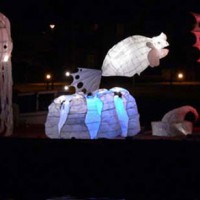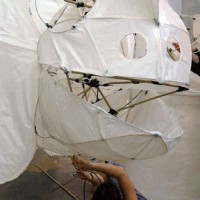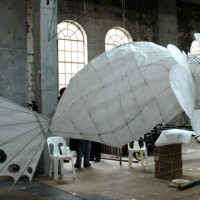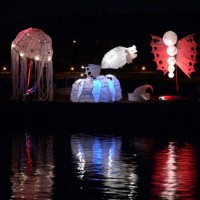Winter Heat
Materials:
Paper, cane, bamboo, wax, wick and water.
Concept:
Winterheat is a mid winter festival held on Friday nights throughout July in different locations around the city of Newcastle.
Flanagan was commissioned by Newcastle Live Sites for the inaugural event in 2004 and again in 2005 to involve the community in a series of creative workshops to produce public artwork for the event. Newcastle Live Sites is an initiative of Newcastle Council, jointly funded by Honeysuckle Development Corporation. Their aim is to bring people into the heart of the city. It does this by coordinating an annual calendar of events around key locations in the city. One of these events is Winter Heat. Flanagan worked with artistic director Michael Cohen to produce what has now become a major event on Newcastle’s cultural calendar.
Using the basic elements of fire and water and cold mid winter evenings, the atmosphere of Winter Heat is akin to the experience of bonfire night that many of us experienced in our childhood. Enticing people to come out in the middle of winter, in 2004 Flanagan let loose five hundred white paper lanterns upstream – they undulated with the rivers motion, lighting up the dark night, as they were drawn slowly with the tide past the public on shore. The crowds drank warm ‘glüwein’ and listened to live music – the whole area glowing from the light of five hundred candles staked on the beach. Everyone keeping warm gathered around burning sculptures (produced by local artists) and fires in 44-gallon drums.
In 2005 the event was repeated but this time Flangan’s workshops focused on creating much larger paper lanterns. Forming a partnership with the local art and design schools, Flanagan worked with the students and other members of the public on a theme of sea creatures and mythical beasties. The resulting creatures floated on individual barges built from wooden pallets, and atop a twelvemeter barge past the crowd of two thousand spectators.
Michael Cohen believes that ‘Temporary public arts projects can invoke a shift in the popular memory of public places and so create a presence that lasts well beyond its actual occupation of the site.’22
The transformative power that you can get by engaging people in this kind of experience creates other benefits, not only developing the cultural sector but also boosting local businesses by increased visitation to the city and improving community safety by creating the sense of a peopled city. 23
Project partners:
Newcastle LiveSites and The University of Newcastle.
Exhibitions:
August 2004, 4 locations around Newcastle harbour. August 2005, 4 locations around Newcastle harbour.
Publications:
QUINN, B. (2005) This Weekend Livesites. The Newcastle Herald. 23rd Jul. ed. Newcastle. P. 30.
QUINN, B. (2005) Candid Comment – Tricia Flanagan. The Daily Telegraph. 2nd Jul. ed. Newcastle. P. 5.
VALLEJO, J. (2005) Fire Sculptures to Set City Alight. The Daily Telegraph. 29th Jun. ed. Newcastle. P. 14.
GADD, M. & EDWARDS, A. (2004) The Creek Lights Up. The Newcastle Herald. 19th Jul. ed. Newcastle. P. 12.
Multi Media:
Mike McLuski, Illuminated Lanterns, 1233 ABC Radio, Newcastle, July 2004.
Thankyou:
Funded by Newcastle LiveSites, with generous support from Michael Cohen, Tathra Witherow, Ben Flanagan, Doug Brownell- Massie, Rhys Caulder-Hoinville, Megan Lewis, Geoff Witnall, Dave Morely and Grit Kading.
Endnotes:
22. COHEN, M. (2009) Place Making and Place Faking: The Continuing Presence of Ephemera. IN LEHMANN, S. (Ed.) Back to the city : strategies for informal urban interventions. Ostfildern, Germany, Hatje Cantz Verlag. P. 143.
23. Ibid. p. 145.



